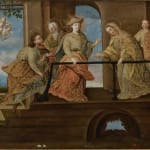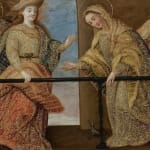DIEGO QUISPE TITO (CIRCLE)
Further images
Provenance
Private Collection.
Due to the technical, aesthetic and stylistic characteristics it presents, this work ought to be placedwithin the 17th-century Cuzco school. It is related to, and bearsmany similarities with, the work of thenative indigenous painter Diego Quispe Tito, one of the most prominent artists from said school, anda follower of Gregorio Gamarra, who was, in turn, a disciple of Bernardo Bitti, one of the school’sfounders, alongside Angelino Medoro and Mateo Pérez de Alesio.
In his works it is easy to discern certain elements of classical Italian painting, which might for instanceinclude the depiction of elongated figures in combination with elements belonging purely to theAmericas, such as the pronounced use of gilding, thereby creating an artistic fusion of two cultures.
The painting before us here presents the aesthetic and stylistic peculiarities with which Diego QuispeTito infused his works, characterized by his agile brushstrokes, painstaking detail and the use of vividcolors. As such, it is worth noting the attention to detail and the finesse in the depiction of the fabricsand dresses, with abundant use of gilding, brocades and gilt relief embroidering. Another frequentfeature is the use of an exuberant landscape replete with flowers.
After the Annunciation by the Angel Gabriel, Mary sets out to visit her pregnant cousin Elizabeth andbe of service to her. The presence of the Word of God (Christ), incarnate in Marywho is the centralimage in the scene, fills Elizabeth with grace, as she stands in front of her, accompanied by a small andrather odd dog of a breed unknown in Europe and the rest ofthe world, the Xoloitzcuintle1. Inspired,she discovers the greatmysteries at work within her young cousin, her elevation to Mother of God, herfaith in the divine word and the sanctification of John the precursor of Christ. Zacharias welcomesthem with a gesture to Saint Joseph, while cherubs flying over the flowery gardens observe andcomment on the joyful scene.
The Gospel of Luke 1:39 tells us that following the Annunciation, Mary went “with haste” to a city ofJudah located in a hilly region. Nowadays this city is most often identified as Ain Karim, four mileswestof Jerusalem.
“And Mary rising up in those days, went into the hill country with haste into a city of Judah. And sheentered into the house of Zacharias, and saluted Elizabeth. And it came to pass, that when Elizabethheard the salutation of Mary, the infant leaped in her womb. And Elizabeth was filled with the HolyGhost; And she cried out with a loud voice, and said: ‘Blessed art thou among women, and blessed isthe fruit of thy womb.
And whence is this to me, that the mother of my Lord should come tome? For behold as soon as thevoice of thy salutation sounded in my ears, the infant in my womb leaped for joy. And blessed art thouthat hast believed, because those things shall be accomplished that were spoken to thee by the Lord.
’”In the interest ofproviding a few significant examples that might serve as a frame of reference for ourwork, we could mention the following pieces by the artist: Saint Joseph with Child, The Flight to Egyptfrom theCelso Pastor de la Torre collection,The Virgin of Carmelfrom Brooklyn Museum and theHoly Family auctionedat Christie’s.







